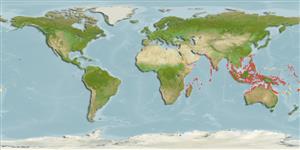>
Blenniiformes (Blennies) >
Blenniidae (Combtooth blennies) > Blenniinae
Etymology: Petroscirtes: Latin, petra, -ae = stone + Greek, skirteo = to jump.
Environment: milieu / climate zone / depth range / distribution range
экология
морской ассоциированный с рифами; пределы глубины 1 - 10 m (Ref. 86942). Tropical; 25°N - 24°S
Indo-West Pacific: Sri Lanka to Fiji, north to southern Taiwan and the Yaeyama Islands, south to the southern Great Barrier Reef.
Size / Вес / Возраст
Maturity: Lm ? range ? - ? cm
Max length : 15.0 cm TL самец/пол неопределен; (Ref. 9710)
Краткое описание
определительные ключи | морфология | морфометрия
колючие лучи спинного плавника (общее число) : 10 - 11; членистые (мягкие) лучи спинного плавника (общее число) : 16 - 19; колючие лучи анального плавника: 2; членистые (мягкие) лучи анального плавника: 16 - 19. Sexually dimorphic: males are orange-brown while females are sea-green dorsally and lighter below. Similar to P. breviceps in shape but has a blotched, rather than lined pattern on the body. Some color form are probably habitat related. The plain form is mainly green and has numerous tiny pearly spots and occurs in seagrass beds (Ref. 48636).
Adults occur in seagrass beds of shallow lagoons. Also in Sargassum rafts during or immediately after wet season (Ref. 48636). Replaced by P. thepassi at Solomon Islands (Ref. 90102). They feed primarily on small crustaceans and occasionally on scales from fishes. Oviparous. Eggs are demersal and adhesive (Ref. 205), and are attached to the substrate via a filamentous, adhesive pad or pedestal (Ref. 94114). Larvae are planktonic, often found in shallow, coastal waters (Ref. 94114). This form was named by Bleeker (1852) as Petroscirtes bankanensis.
Life cycle and mating behavior
половая зрелость | размножение | нерест | икра | Fecundity | личинки
Oviparous, distinct pairing (Ref. 205).
Myers, R.F., 1991. Micronesian reef fishes. Second Ed. Coral Graphics, Barrigada, Guam. 298 p. (Ref. 1602)
Статус Красного Списка МСОП (Ref. 130435: Version 2024-1)
Угроза для людей
Harmless
Использование человеком
дополнительная информация
инструменты
Специальные отчеты
Скачать в формате XML
ресурсы в Интернет
Estimates based on models
Preferred temperature (Ref.
123201): 26 - 29.3, mean 28.6 °C (based on 2654 cells).
Phylogenetic diversity index (Ref.
82804): PD
50 = 0.5005 [Uniqueness, from 0.5 = low to 2.0 = high].
Bayesian length-weight: a=0.00575 (0.00253 - 0.01308), b=3.06 (2.86 - 3.26), in cm total length, based on LWR estimates for this (Sub)family-body shape (Ref.
93245).
Trophic level (Ref.
69278): 3.1 ±0.43 se; based on food items.
устойчивость к внешним воздействиям (Ref.
120179): высокий, минимальное время удвоения популяции до 15 месяцев (Preliminary K or Fecundity.).
Fishing Vulnerability (Ref.
59153): Low vulnerability (10 of 100).
Nutrients (Ref.
124155): Calcium = 113 [58, 171] mg/100g; Iron = 0.683 [0.413, 1.114] mg/100g; Protein = 18.4 [17.3, 19.4] %; Omega3 = 0.085 [0.048, 0.146] g/100g; Selenium = 21.3 [10.7, 42.6] μg/100g; VitaminA = 124 [40, 369] μg/100g; Zinc = 1.83 [1.25, 2.56] mg/100g (wet weight);
